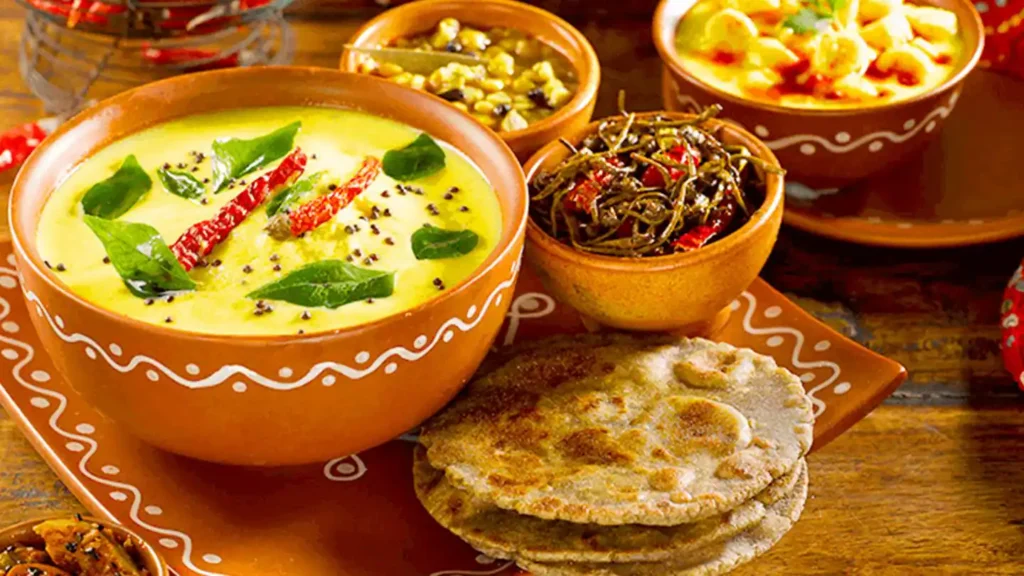Rajasthan’s royal cuisine features rich flavors, unique cooking techniques, and luxurious ingredients. While many associate Rajput royalty with meat-based dishes like Laal Maas, the royal kitchens of Rajasthan also perfected an exquisite array of vegetarian delicacies. These dishes reflect seasonal availability, arid climate, and royal preferences, making them an integral part of Rajasthani cuisine.

1. Gatte Ki Sabzi: The Regal Gram Flour Curry
Gatte Ki Sabzi stands out as one of Rajasthan’s most famous vegetarian dishes. Gram flour (besan) dumplings simmer in a rich, spiced yogurt-based curry. The royal version includes saffron, dry fruits, and desi ghee for enhanced richness.
2. Dal Baati Churma: The King’s Favorite Staple
Dal Baati Churma served as a staple for Rajput warriors. The dish combines crispy baked wheat dumplings (baati) with lentil curry (dal) and sweet, crumbled wheat dessert (churma). Royal kitchens prepared ghee-soaked baatis and saffron-infused churma, often adding dry fruits and nuts for a richer taste.
3. Govind Gatte: A Royal Twist on a Classic Dish
Govind Gatte offers a richer version of Gatte Ki Sabzi. These gram flour dumplings come stuffed with dry fruits and khoya (reduced milk). A thick tomato-based gravy enhances the dish’s luxurious taste, while saffron and fresh coriander add the finishing touch.
4. Ker Sangri: The Desert’s Royal Delicacy
Ker Sangri uses wild berries (ker) and dried beans (sangri), ingredients commonly found in Rajasthan’s desert regions. Royal kitchens slow-cooked the dish in ghee, curd, and aromatic spices, creating a flavorful and nutrient-rich meal.
5. Rajasthani Kadhi: A Yogurt-Based Royal Treat
Unlike regular kadhi, Rajasthani Kadhi delivers a spicy, ghee-infused flavor with bold red chili notes. Fried gram flour dumplings (pakoras) enrich the dish, and special royal versions featured saffron and dry fruits for added depth.
6. Panchmel Dal: The Five-Lentil Royal Protein Dish
Panchmel Dal blends five different lentils—toor, moong, chana, masoor, and urad dal—to create a protein-rich dish. Royals paired it with baati or jeera rice, often slow-cooking it with ghee, cloves, cinnamon, and dried red chilies for a bold, smoky aroma.
7. Rajasthani Safed Paneer: The Royal White Curry
Safed Paneer stands out as a rich, creamy dish featuring paneer (cottage cheese), cashew paste, khoya, and fresh cream. Cardamom, white pepper, and rose water enhance its delicate flavor, making it a preferred dish for royal banquets and special occasions.
8. Mawa Kachori: The Sweet Indulgence of Kings
Unlike traditional savory kachoris, Mawa Kachori presents a sweet variation filled with mawa (khoya), nuts, and cardamom. The kachoris undergo deep-frying before soaking in saffron-infused sugar syrup. The royal kitchens of Jodhpur and Udaipur popularized this festive delicacy.
9. Bajre Ki Roti with Lehsun Chutney: The Rajputana Warrior Meal
Bajre Ki Roti (pearl millet flatbread) served as a staple in Rajput warrior diets. Paired with spicy garlic chutney (Lehsun Chutney) made from red chilies, garlic, and ghee, the dish provided energy and warmth. Royals often enjoyed it with makhan (homemade butter) and jaggery.
10. Badam Ka Halwa: The Royal Winter Delight
Badam Ka Halwa delighted Rajasthan’s royalty with its rich almond, saffron, ghee, and cardamom composition. This warm, nutrient-dense dessert kept the nobility energized during harsh winter months.
Conclusion
Rajasthan’s royal kitchens crafted vegetarian delicacies that matched the richness of their meat-based counterparts. Ghee, dry fruits, and aromatic spices played essential roles in these dishes. Today, these royal recipes remain popular in traditional households, heritage hotels, and festive celebrations, preserving the legacy of Rajput cuisine.

